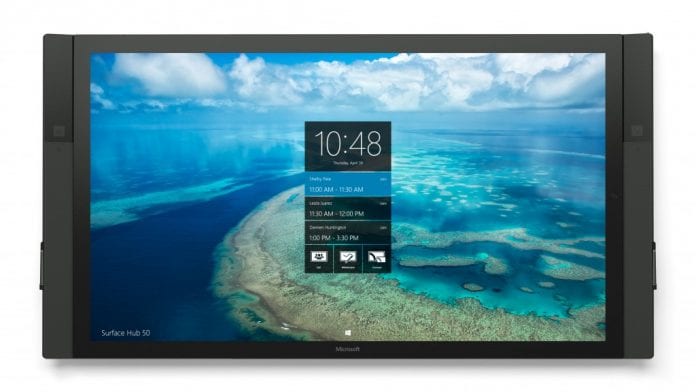With this one, Microsoft has, apparently, hit a hardware bullseye which pretty much took everyone by surprise even the “big heads” over at Redmond. The hardware we are referring to is the Surface Hub conference room PC that turned out to be selling like crazy which surpassed everyone’s expectations.
If you recall, Microsoft launched its Surface Hub conference room computers about a year and a half ago, and nobody back then didn’t know what to think of them. The only thing that worked in its favor was the fact it offered a pretty cool mix of video conferencing, digital whiteboarding, and collaborative working with a low price that was $6,999 for the 55 inch and $19,999 for the 84-inch version.
Back then meeting rooms were a thing of the old tech that held on to the bitter end with the massive amount of VGA ports, outdated video conferencing systems that were the norm and a whiteboard that was as hi-tech as it could get. When Microsoft took all of this into consideration, they saw a huge and demanding market and proceeded with the creation of the Surface Hub. Initially, it was supposed to be announced in September 2015, but it got pushed until January 2016 with the company claiming that a much higher demand than they predicted (especially for the 84-inch version) meant that they needed to change their manufacturing capacities. This also gave them an opportunity to raise the price up for about $2.000 for both models (to $8.999 and $21.999) which only suggested that demand wasn’t lacking in any way.
As Microsoft acknowledged, they thought that companies would opt for a few of the Surface Hub systems just to see how they fit in they workflow and organizations. If they took it up good, and if those companies were ready to make a transfer to Skype for Business, Exchange integration, a custom version of Windows 10 and more, Microsoft would make a few more sales from this trial. But as it turns out they found that it wasn’t going to be as they planned. Apparently, an average Surface Hub customer is buying about 50 devices for each deployment, and thanks to that Microsoft has reached more than 2.000 customers. One car manufacturer (which shall remain unnamed) 1.500 of the things, which just goes to show how much demand is for them. Microsoft isn’t too keen on revealing the exact mix between purchased sizes of the Surface Hub, but nevertheless, this just shows that it is another billion-dollar-a-year business for this software giant, which managed to nail this one from version one.
https://www.youtube.com/watch?v=FRLDRQePY1o
Just to show to those who still do not believe in their product, Microsoft commissioned a Forrester report that revealed that meetings that have the Surface Hub start more promptly (without someone having to fiddle with pairing devices or getting PC’s hooked up to the projector) meaning they save up to 23 minutes per meeting. The company also released one more piece of info, although a lot less measurable, saying that thanks to Surface Hub greater meeting engagement is accomplished with people standing up and engaging with each other on the screen rather than hiding behind their laptop or playing games on their phones.
Microsoft also plans to add new value-added resellers for the systems in 2017, which are supposed to coordinate installation, integration with AV systems, and custom application development. They will also offer “Try and Buy” scheme where the customers will be getting up to five units at a discount for 30 days before placing any larger order. Microsoft also feels that its other Surface products are doing pretty good, despite the fact that they didn’t have any major hardware refreshes, with November as a top month ever for consumer Surface sales with a Best Buy promotion. On that topic, it is important to tell you that faster and longer-lasting Surface Book with Performance Base is now available in Australia and New Zealand, in addition to the US and Canada. Early next quarter, it will be introduced to markets of Austria, China, France, Germany, Hong Kong, Japan, Switzerland, and the UK.









